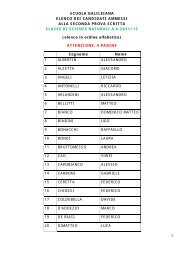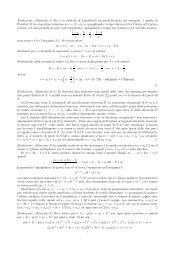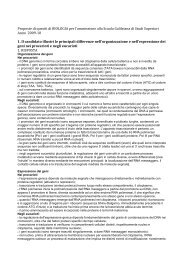Brochure didattica a.a. 2010-2011 - Scuola Galileiana di Studi ...
Brochure didattica a.a. 2010-2011 - Scuola Galileiana di Studi ...
Brochure didattica a.a. 2010-2011 - Scuola Galileiana di Studi ...
Create successful ePaper yourself
Turn your PDF publications into a flip-book with our unique Google optimized e-Paper software.
Littlewood, il teorema <strong>di</strong> <strong>di</strong>fferenziazione <strong>di</strong> Lebesgue, i teoremi <strong>di</strong> Morrey, <strong>di</strong> A.P. Calderòn, <strong>di</strong><br />
Rademacher-Stepanov, e <strong>di</strong>suguaglianze <strong>di</strong> tipo Poincaré, Sobolev e isoperimetriche.<br />
La parte geometrica è stata costituita da un'introduzione al bagaglio essenziale della geometria<br />
riemanniana, quali l'operatore <strong>di</strong> Laplace-Beltrami e il semigruppo del calore ad esso associato, il<br />
tensore <strong>di</strong> curvatura <strong>di</strong> Riemann, il tensore <strong>di</strong> Ricci, la teoria dei campi <strong>di</strong> Jacobi su cui poggiano i<br />
fondamentali risultati <strong>di</strong> confronto, quali il \comparison theorem" per l'operatore <strong>di</strong> Laplace-<br />
Beltrami e quello <strong>di</strong> Bishop-Gromov per il volume delle palle geodesiche.<br />
L'analisi e la geometria si sono poi coniugate nella parte del corso de<strong>di</strong>cata alla <strong>di</strong>mostrazione del<br />
“soap bubble theorem" <strong>di</strong> A. D. Alexandrov, al teorema <strong>di</strong> Bernstein sui grafici minimali, alla<br />
<strong>di</strong>suguaglianza <strong>di</strong> Harnack <strong>di</strong> Li-Yau per l'operatore del calore su una varietà avente tensore <strong>di</strong><br />
Ricci ≥ 0.<br />
Inizio del corso: I Trimestre<br />
RETI NEURONALI E INTELLIGENZA ARTIFICIALE<br />
(Prof. Alessandro Treves)<br />
Neural networks and the evolution of neural computation<br />
My course, in response to suggestions by SISSA student, will follow closely the presentation in<br />
Rolls and Treves, Neural Networks and Brain Function, Oxford UP, 1998, covering roughly one<br />
chapter or appen<strong>di</strong>x per meeting, with some extras. Students are advised to photocopy the whole<br />
book, and read the relevant chapters in advance of each meeting. After the meeting, they can read<br />
the ad<strong>di</strong>tional material or review the slides I will use and <strong>di</strong>stribute. The slides and all the material<br />
are in English, but if all the students in Padova speak Italian we can have the meetings in a flexible<br />
Italo-English.<br />
We should meet twice a week, for 11 weeks, with a schedule yet to be decided.<br />
The scheme to be followed per week will be<br />
Week 1: Introduction, and overview of research <strong>di</strong>rections in LIMBO, in one slide and loosely<br />
based on Ch. 1 of the book + App. 1 – Introduction to linear algebra<br />
Week 2: App. 2 (partial) – Elements of information theory + (no Chapter or Appen<strong>di</strong>x) – Geometry<br />
based computation: redundancy reduction à la Atick, from JJ Atick, ecological theory of sensory<br />
processing, Network 3:213 (1992).





